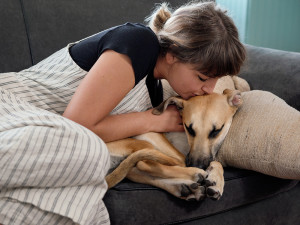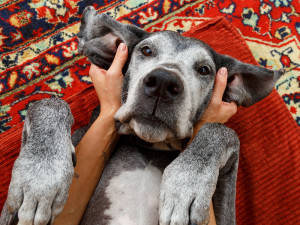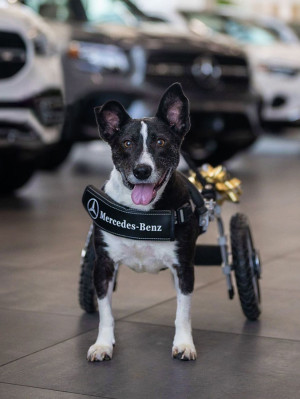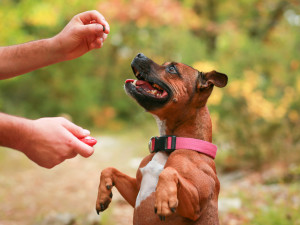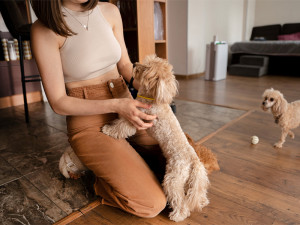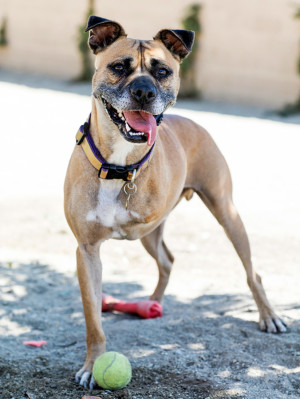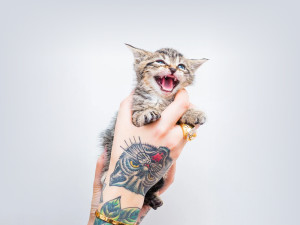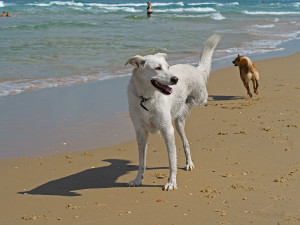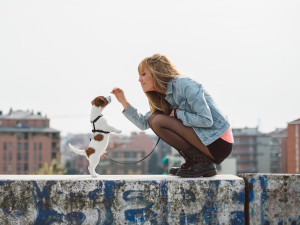7 Things I Wish People Knew About My Deaf Dog—and Why You Should Adopt One
I’m finally saying what I’ve been thinking since the day I brought my pup home.
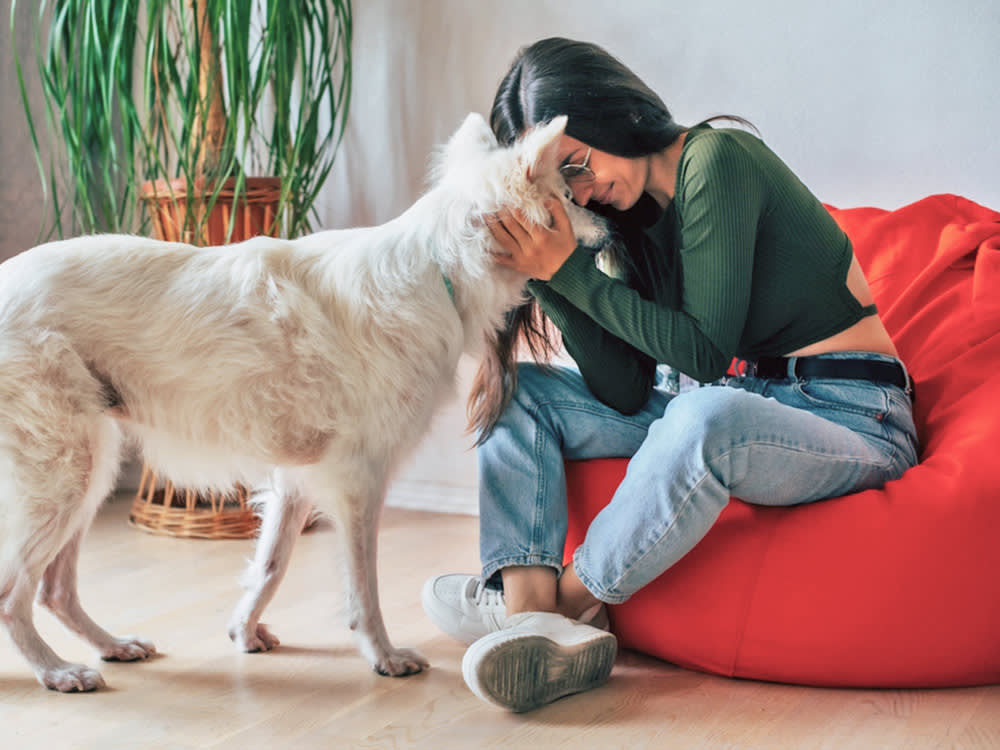
Share Article
When I got my dog Georgie I had just turned 26 years old. My partner and I had only been together for 10 months, had very little expendable income, and exactly zero business adopting a pet at that point in our lives.
But there she was, with Golden Retriever ears that were too big for her face, Red Heeler markings (one of which looks exactly like a heart), and perpetually concerned Cocker Spaniel eyes. And we were a family of three for five years. She was our girl. The OG (original Georgie). Our one and only baby. That was, until we met Charlie.

littleKin™ is Kinship’s home just for puppy and kitten parents. Bop over to check out expert advice, new pet tools, and special deals—all curated for your newest family member.
opens in a new tabMy deaf dog is the best boy.
Originally known as Duke when we first adopted him, he was a seven-month-old, spindly little guy whose mother had been abandoned and rescued while pregnant. The first thing we noticed when we went to meet him and his foster was that he followed the other dogs at the park wherever they went. He never went off on his own and always stayed close to the pack, careful to follow their every move. And that, we found out, is because Charlie is deaf.
Charlie — or Prince Charles (no relation, to be clear), Chuck, Charles Entertainment Cheese, or The Boy — as he is also affectionately known in our householdopens in a new tab — is what is referred to as “a double merle.” This is what happens when two dogs with a spotted “merle” pattern on their coats — think Australian Shepherds — breed. To quoteopens in a new tab the resource and adoption site Deaf Dogs Rockopens in a new tab (DDR), where his foster, an American Sign Language (ASL) interpreter and dog trainer, initially found Charlie: “If two merle dogs are bred together, each puppy in the litter has a 25 percent chance of being born a double merle. A double merle inherits the merle gene twice.”
This double copy then results in a lightening effect, which means the resulting puppy will have a white coat and will lack pigmentation around their eyes and on their nose (it’s a whole high-school biology punnett square thing). And they will also likely be deaf or blind — or both.
We didn’t set out to get a deaf dog, but once we saw Georgie and Charlie interact, we knew he was the right second pup for us. Because of his deafness, he benefits from having a hearing sister who looks out for him, and as a Cattle Dog mix, she likes having a job. She’s his ears when he needs her to be.
To celebrate Deaf Dog Awareness Week, I spoke with DDR founder Christina Lee — who was inspired to start the organization in 2012, two years after adopting her deaf Boxeropens in a new tab Nitro — about what we wish people knew about deaf dogs and other deaf pets. We also make the case for why you should adopt these animals, who are often surrendered to shelters, as overcrowding is on the riseopens in a new tab across the U.S.
They are the best pals.
Georgie is a sweet girl, and she likes cuddles… on her own terms. If I don’t pet her enough during a Zoom meeting, she’ll grumble at me so loud that my boss once asked if the sounds were coming from a human being. But she’s not a snuggler. Charlie, though, is a classic Velcro dog (as deaf dogs tend to be). He wants to be as close to me as he possibly can; it’s comforting for him to feel someone next to him. Unlike Georgie, he can’t rely on his ears to pick up any startling sounds that would jolt him out of sleep. He relies on feel, so if I suddenly stand up, he snaps awake to see what I’m reacting to.
He sleeps like a human being with his head on my or my partner’s pillow and, because he can’t hear me, he needs to see me at all times. Yes, that does mean he occasionally pokes his head into the shower to make sure I’m still there and didn’t magically disappear into Narnia or something. Would I prefer to shower alone? Sure.
But I also feel pretty flattered by his devotion. He has the energy of a little kid who doesn’t understand romantic partnerships yet and says, “I want to marry Mommy.” The bonus? He’ll never grow out of that phase — I hope. “You do have to be OK [with] never having any personal space again, but it is so worth the sacrifice,” Lee tells me.
They can be just as easy to train as any other dog.
It’s important to remember that what makes dogs different don’t make them harder to train, necessarily. We train Charlie the same way we train Georgie, except with a slightly altered approach. With her, we use a clicker, so she can hear the “click” when she completes a task. Then we give her a treat. With Charlie, after he sits, comes, waits, etc., we just flick a thumbs up — more of a visual clicker. And then, of course, he gets a treat.
“We don’t consider deaf dogs or deaf/blind dogs disabled. We think of them as differently abled,” Lee says. “They are just as easy to train and live with their human families as a hearing dog, and the training is very similar. My deaf dogs all excel in all their training classes, therapy classes, and agility classes.opens in a new tab”
She adds that “the sky is the limit” if pet parents make a commitment to positive reinforcement training with their deaf dog and points to all the accomplished pups featured on their siteopens in a new tab.
They are a dog first — and should be treated as such.
Your dog’s so-called disability does not define them. Lee says the reason so many dogs who are listed as having disabilities may have a harder time getting adopted is that people see the disability first. At Deaf Dogs Rock, Lee says they tend to lead with the adoptable dog’s breed and personality. Deafness is third on the list.
They are so smart.
Georgie is our little honors student; we always joke that she’s that “actually” person in class who’s always correcting other kids when they get an answer wrong. But Charlie is just as smart. He knows several ASL signs, and through our training with him, we’ve learned a lot of ASL, too. But more importantly, he’s emotionally intelligent. He can tell when I’m having a hard mental health day and instantly checks on me, deploying his very best “Velcro” snuggle therapy as he sticks to my side for a couch cuddle.
Lee says the same things about the deaf dogs in her life, adding that deaf dogs have “super powers” because they are so tuned into their environments. “My deaf dogs can feel the vibration of the UPS truck a quarter of a mile down the road way before my hearing dogs alert us," she says. “They can also sense darkness (like an empath), and they can recognize good people but also pick up on negative energy from bad people.”
They may communicate differently—but that doesn’t make it wrong.
Because he can’t hear himself to regulate his own volume, my boy is a loud barker. This has led some fellow pet parents to interpret that as aggression. In reality, he’s simply playing and asking his pals to play along with him — he’s just loud about it.
“It really is about educating people when it comes to your deaf dogs playing with new dogs,” Lee says, adding that it’s always helpful to give other dog parents a heads up by saying something like, “‘My dog is completely deaf and he sounds ferocious because he can't hear himself, but rest assured it is just his way of playing.’”
As much as I wish I didn’t have to do this and that everyone would automatically accept Charlie for who he is, it is my job to be his advocate in this world. And it’s the least I can do for my favorite person (he’s a human being; please don’t refute that).
Lee says that, before DDR dogs get adopted, it’s her team’s role to be their champions. Again, this starts with not focusing on their disabilities, but rather on who they are and the kind of family they need. “It is more important to advertise for a committed, loving forever home with someone who is really serious about daily positive reinforcement training and being the deaf dog’s advocate in every situation,” she says.
Helping them feel comfortable in their new home and family is so rewarding and joyous.
As settled as we were in our life with Georgie, Charlie completed our family. Lee tells me that the best part of having deaf dogs is seeing that “light bulb” go on in their heads when they learn a new sign or master something new. For me, it’s knowing that he feels safe with me and in our home. When he’s nuzzled up against me, he can sleep soundly with the knowledge that I’m protecting him. And I feel immense comfort from a companion who reminds me that external silence is valuable — especially when my mind is often full of nothing but anxious chatter.
“We say that deaf dogs are like potato chips; you can’t just have one!” Lee says, and it makes perfect sense to me. Charlie is my first deaf rescue dog, but he’s certainly not my last. All it takes is opening yourself up to understanding a different way of training and of looking at the world. Unfortunately, many people don’t take the time to do this. Lee says that right now, DDR is seeing that hundreds of deaf dogs — most of them between the ages of eight months and 1.5 years old — are being surrendered at shelters.
“Many times, it is because someone adopted a deaf dog and then did zero training/socialization and the deaf dogs end up being put outside on a chain or stuck in the backyard until the owners do an owner surrender and take them to the shelter.” She adds that there is a huge need for fosters of deaf or deaf and blind dogs right now, in addition to adopters. So, if I’ve done anything to convince you that a deaf dog would only make your family better (and I hope I did), please check out DDR’s adoptable dogs opens in a new tab and educational resourcesopens in a new tab right now.
References:

Hilary Weaver
Hilary Weaver is the senior editor at Kinship. She has previously been an editor at The Spruce Pets, ELLE, and The Cut. She was a staff writer at Vanity Fair from 2016 to 2019, and her work has been featured in Esquire, Refinery 29, BuzzFeed, Parade, and more. She lives with her herding pups, Georgie and Charlie.
Related articles
![Three-legged Boxer mix playing with a tennis ball at a dog park.]() opens in a new tab
opens in a new tabMeet This Inspiring Online Community of Parents to Three-Legged Pets
“We learned dogs are born with three legs and a spare.”
![A hand holding a kitten with a cat tattooed at the hand.]() opens in a new tab
opens in a new tabAnimal Shelters Are in “Crisis” Due to the Rising Cost of Living
Overcrowding is at an all-time high.
![Three-legged white dog at the beach]() opens in a new tab
opens in a new tabHow to Keep Your Three-Legged Dog Outpacing All the Other Pups at the Park
6 tips to help your tripod dog stay in tip-top shape.
![Dog trainer reinforcing good behavior with a young boxer dog on a dog training field]() opens in a new tab
opens in a new tabThese Reinforcement Techniques in Dog Training Will Make Rules Fun for Both of You
Offering fewer treats can actually be a good thing.
![Young blonde woman with a Jack Russell puppy during spring in the city.]() opens in a new tab
opens in a new tabThe Best Training Treats for Dogs in 2025
The most mouth-watering treats for training your pup.
